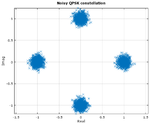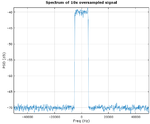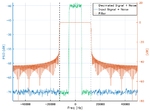stenzer
Advanced Member level 3

Hi,
I'm curious how a FIR decimation filter improves the Signal to Noise Ratio of a digitized signal. I have read a decimation by N = 2 leads (theoretically) to an improvement of 3 dB. So where does this 3 dB come from?
By having a look at Oppenheim's Signals & Systems, I have seen that the frequency spectrum is widened by the decimation factor (so -w_M to +w_M gets -2.w_M to +2.w_M for N = 2). So I assume, for a constant noise power in the range of -w_M to +w_M, the same "amount" of noise is spread in the range of -2.w_M to +2.w_M, for a decimation of 2.
Thus a decimation by N = 2 (-2.w_M to +2.w_M) in combination with a low pass filter which reduces the bandwidth by N = 2 (-> -w_M to +w_M) leads to the same bandwith, with a reduced noise contribution by N. So for N = 2, the noise bandwidth is halved and leads to a reduction of sqrt(2), where the effective voltage noise V_M is determined by V_n = e_n . sqrt(Bandwidth), with e_n as the voltage noise spectrale densety in V/sqrt(Hz). This leads to 20.log10(sqrt(2)) = 3 dB.
Are my thoughts correct, or have I missed something?
BR
I'm curious how a FIR decimation filter improves the Signal to Noise Ratio of a digitized signal. I have read a decimation by N = 2 leads (theoretically) to an improvement of 3 dB. So where does this 3 dB come from?
By having a look at Oppenheim's Signals & Systems, I have seen that the frequency spectrum is widened by the decimation factor (so -w_M to +w_M gets -2.w_M to +2.w_M for N = 2). So I assume, for a constant noise power in the range of -w_M to +w_M, the same "amount" of noise is spread in the range of -2.w_M to +2.w_M, for a decimation of 2.
Thus a decimation by N = 2 (-2.w_M to +2.w_M) in combination with a low pass filter which reduces the bandwidth by N = 2 (-> -w_M to +w_M) leads to the same bandwith, with a reduced noise contribution by N. So for N = 2, the noise bandwidth is halved and leads to a reduction of sqrt(2), where the effective voltage noise V_M is determined by V_n = e_n . sqrt(Bandwidth), with e_n as the voltage noise spectrale densety in V/sqrt(Hz). This leads to 20.log10(sqrt(2)) = 3 dB.
Are my thoughts correct, or have I missed something?
BR



